Example: Customizing User Interface Using Custom Lightning Types with Editor and Renderer Overrides
This example explains how to override the default user interface to create a customized appearance of responses on the custom agent’s action input and output with custom Lightning types.
In this example, you specify an editor override and a renderer override for the custom Lightning type that you created.
Download these sample data files.
Use these Apex classes together to create a custom agent action that finds flights. The main FlightAgent class contains the invocable method, and the other classes define the complex data structures for the request and response.
When you create your custom agent action, select the method Find Flights.
FlightAgent Class
This class is the main class that contains the logic for the Find Flights agent action. It also defines the FlightRequest and FlightResponse inner classes to handle the action's input and output.
AvailableFlight Class
This class defines a list that holds multiple Flight objects.
Flight Class
This class defines the data structure for flight details.
FlightRequestFilter
This class defines the data structure for the optional filters a user can apply when searching for flights.
The Apex class FlightAgent accepts the flight search criteria, including the origin city, destination city, and date of travel, and then returns a list of available flights.
For this example, flight availability data is already included in the FlightAgent Apex class. However, in a real-time scenario, flight information is fetched from an external service, and the Apex class processes that data to generate the final response.
For information about how to create a custom action by using Apex class, see Create a Custom Agent Action.
Inputs and outputs for the agent action are defined by using standard Lightning types and Apex classes.
Input:
dateOfTravel,destinationCity, andoriginCityuse standard Lightning types such as lightning__dateType and lightning__textType.- The
filtersinput is a complex type that references an Apex class.
Output:
- The output
aFlightfor the agent action is a complex type that references an Apex class.
Here’s an image that shows the custom agent action created.
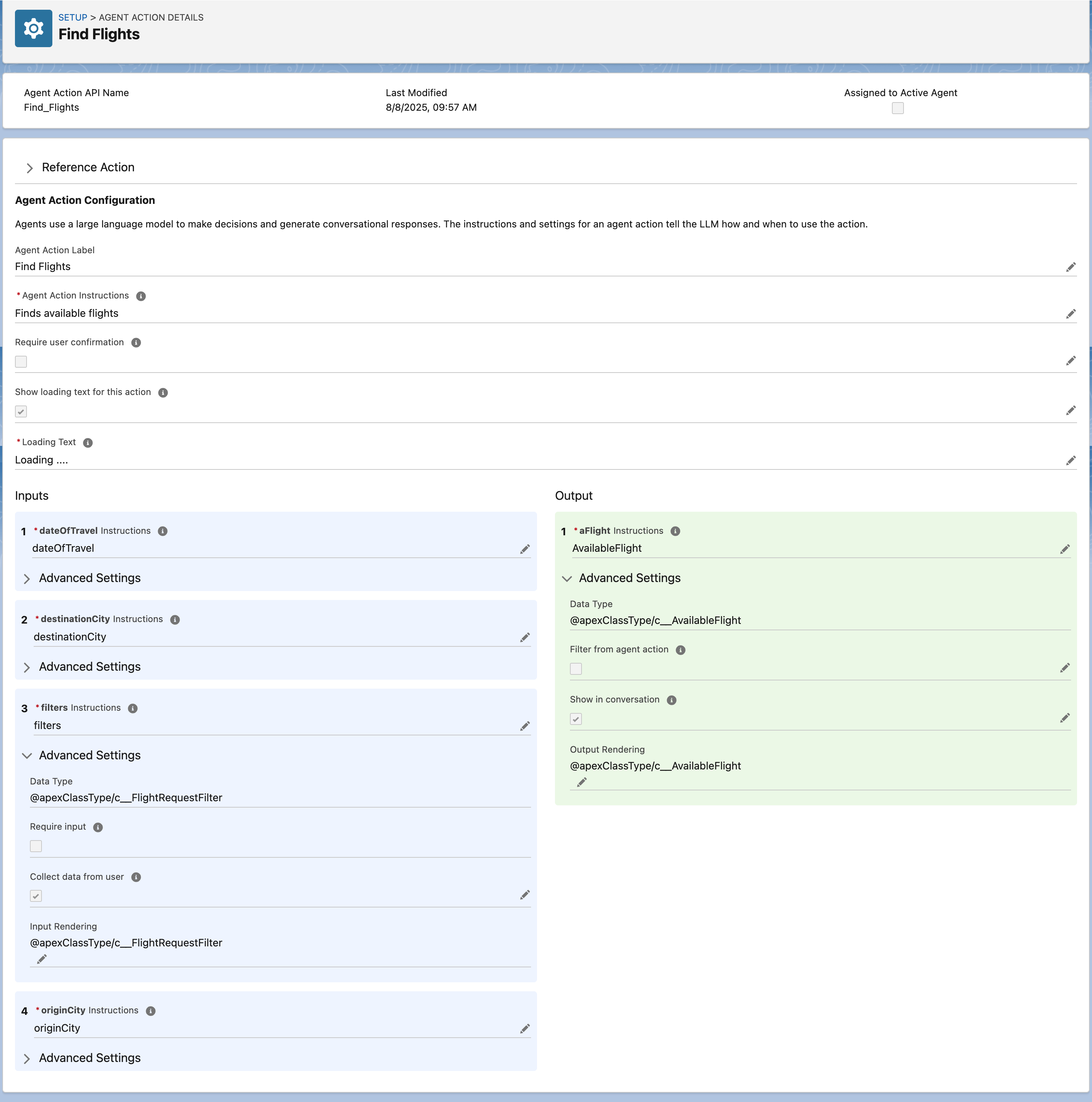
The available flight information is retrieved by using @apexClassType/c__AvailableFlight in the agent action output, where:
apexClassTypeis the bundle name.AvailableFlightis the Apex class.
When you execute this agent action, it prompts you to provide input and then generates the output.
The agent’s action UI collects these details to find available flights.
- Origin city
- Destination city
- Date of travel
Here’s the image that shows how the custom agent action input appears in an agent conversation.
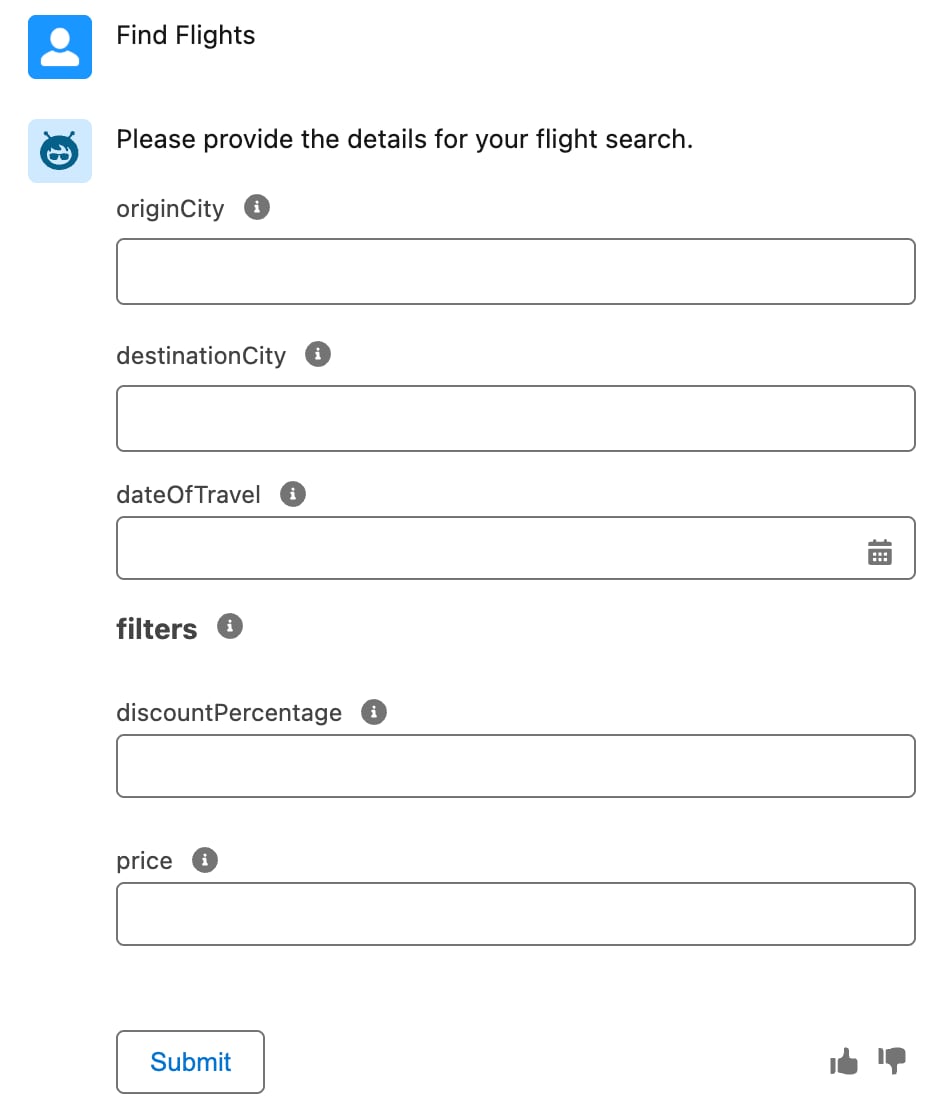
The agent’s action UI returns the available flight details.
Here’s the image that shows how the custom agent action’s output appears in an agent conversation.

The agent displays the flight data in the response.
Here’s the sample code that shows the available flight data.
Create a custom Lightning type named flightResponse to enhance the visibility of the information in the output UI.
Override the agent’s action UI for output to enhance the user experience by using Custom Lightning Types (CLTs). With CLTs, you can add your own Lightning Web Components (LWC) to present data in a more structured and intuitive format.
Configure the renderer.json file to override the default UI of a custom Lightning type in the agent action.
Here’s an example showing a lightningTypes folder for a custom Lightning type named flightResponse.
The custom Lightning type flightResponse includes a schema.json file and a renderer.json file. The renderer.json file controls how the data is displayed to the user in the agent action output.
This sample code shows the contents of the schema.json file.
This sample code shows the contents of the renderer.json file.
See Also
- Metadata API Developer Guide: LightningTypeBundle
This section explains how the components are created and deployed for agent action output.
This image shows the Lightning Web Component (LWC) folder structure.
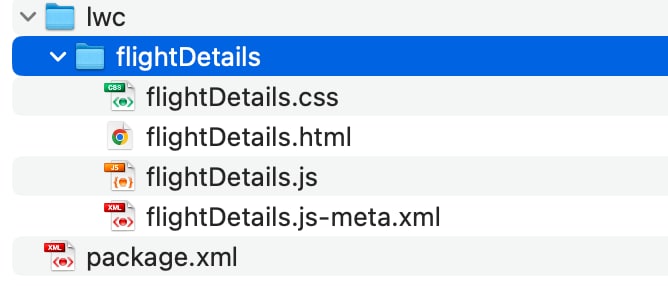
The LWC component includes HTML markup designed to represent the data that the agent returns for @apexClassType/c__AvailableFlight. This HTML markup ensures that the data is displayed in an intuitive and customized format.
This sample code shows the contents of the flightDetails.js-meta.xml file.
When you create an LWC component to override the UI for action input, use lightning__AgentforceInput as the target. For output, use lightning__AgentforceOutput. For information about LWC target types, see lightning__AgentforceInput and lightning__AgentforceOutput.
This sample code shows the contents of the flightDetails.html file.
This sample code shows the contents of the flightDetails.js file.
See Also
- Lightning Web Components Developer Guide: Get Started with Lightning Web Components
To add a custom Lightning type to the agent action, complete these steps.
- Open the agent action.
- Edit the
Output Renderingparameter of the agent action output foraFlight. - Select the custom lightning type
flightResponse. - Save the agent action.
The Unsupported Data Type message appears in the Map to Variable parameter. You see this message when you refer to types such as @apexClassType and custom Lightning types in an agent action’s Output Rendering parameter. This message doesn’t affect your saved work and can be safely ignored.
This image shows the custom Lightning type that you created.
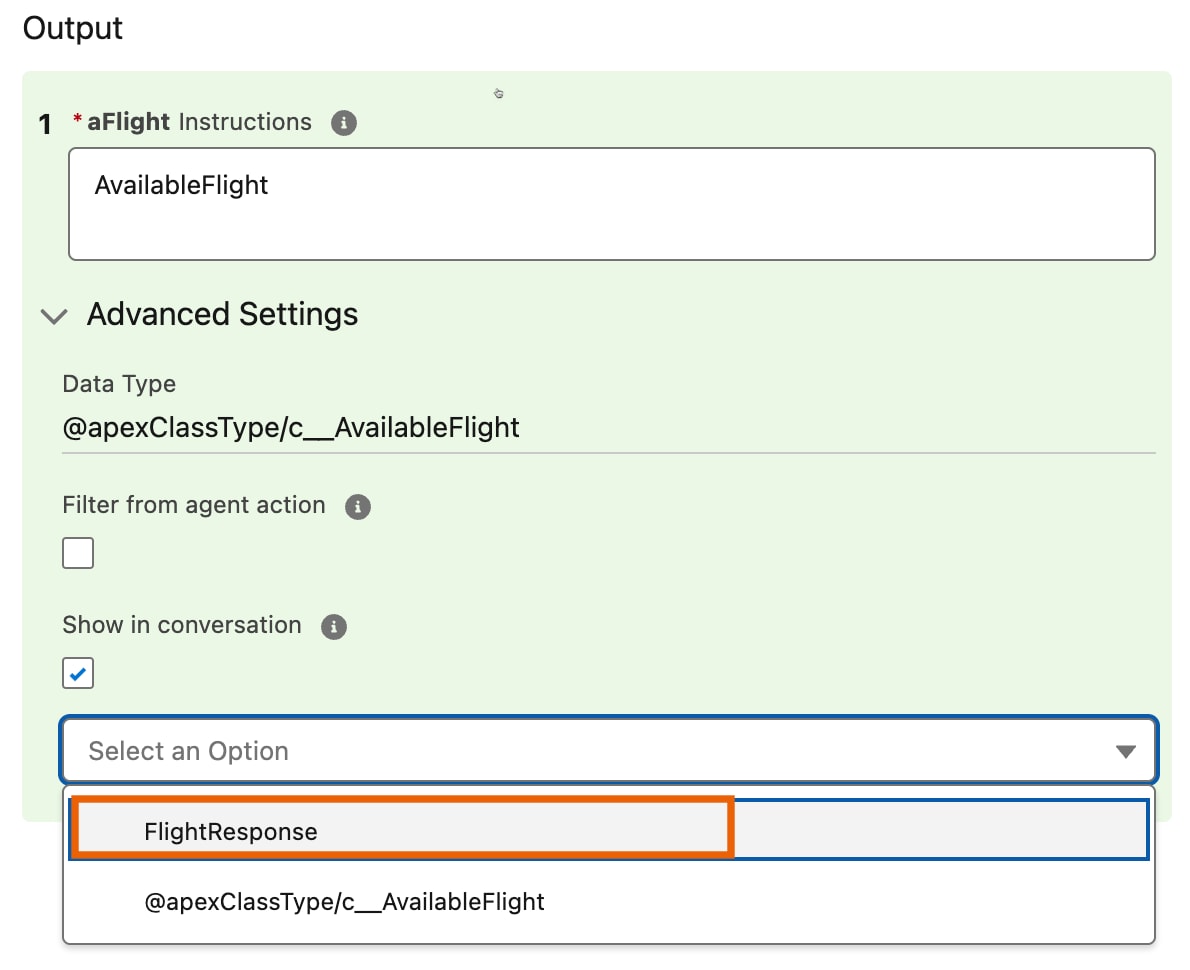
Before executing the agent action that you modified, reload the agent page. The agent prompts you to provide input and then generate the output. The output provides a new UI experience.
This image shows how the custom agent action’s output appears in an agent conversation.
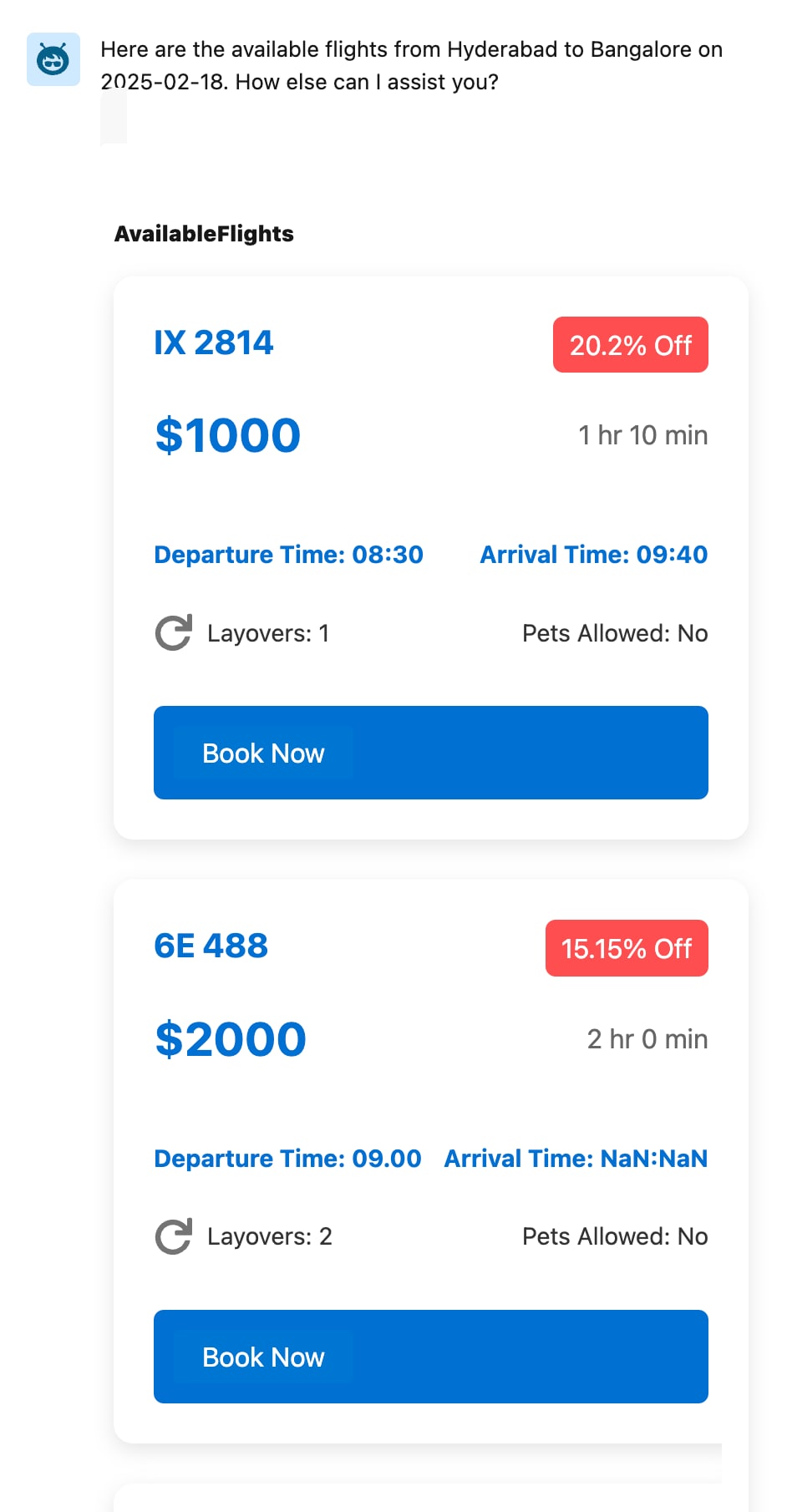
Create a custom Lightning type named flightFilter to show filters in the input UI that suits your business needs.
Override the agent’s action UI for input to enhance the user experience by using Custom Lightning Types (CLTs). With CLTs, you can add your own Lightning Web Components (LWC) to present data in a more structured and intuitive format
Configure the editor.json file to override the default UI of a custom Lightning type in the agent action.
Here’s an example that shows a lightningTypes folder for a custom Lightning type named flightFilter.
The custom Lightning type flightFilter includes a schema.json file and an editor.json file. The editor.json file controls how the data is displayed to the user in the agent action input.
This sample code shows the contents of the schema.json file.
This sample code shows the contents of the editor.json file.
See Also
- Metadata API Developer Guide: LightningTypeBundle
This section explains how the components are created and deployed for agent action input.
This image shows the Lightning Web Component (LWC) folder structure.
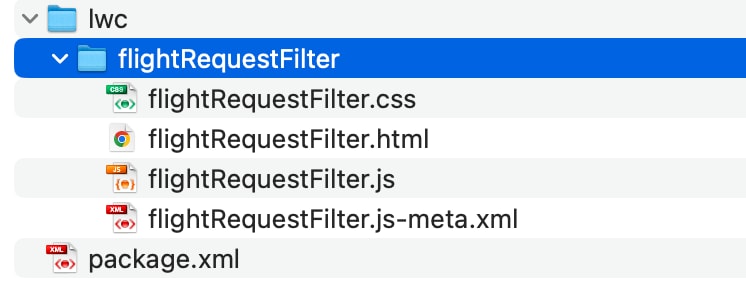
The LWC component includes HTML markup designed to accept input for @apexClassType/c__FlightRequestFilter. This HTML markup ensures that the data is displayed in an intuitive and customized format.
This sample code shows the contents of the flightRequestFilter.js-meta.xml file.
When you create an LWC component to override the UI for action input, use lightning__AgentforceInput as the target. For output, use lightning__AgentforceOutput. For information about LWC target types, see lightning__AgentforceInput and lightning__AgentforceOutput.
This sample code shows the contents of the flightRequestFilter.html file.
This sample code shows the contents of the flightRequestFilter.js file.
You must include the handleInputChange() function to capture user input, update the component’s state, and notify the parent component (planner component) by using the valuechange event. The function ensures real-time data binding and prevents unwanted event propagation.
See Also
- Lightning Web Components Developer Guide: Get Started with Lightning Web Components
To add a custom Lightning type to the agent action, complete these steps.
- Open the agent action.
- Edit the
Input Renderingparameter of the agent action input forfilters. - Select the custom lightning type
flightFilter. - Save the agent action.
The Unsupported Data Type message appears in the Map to Variable parameter. You see this message when you refer to types such as @apexClassType and custom Lightning types in an agent action’s Input Rendering parameter. This message doesn’t affect your saved work and can be safely ignored.
This image shows the custom Lightning type that you created.
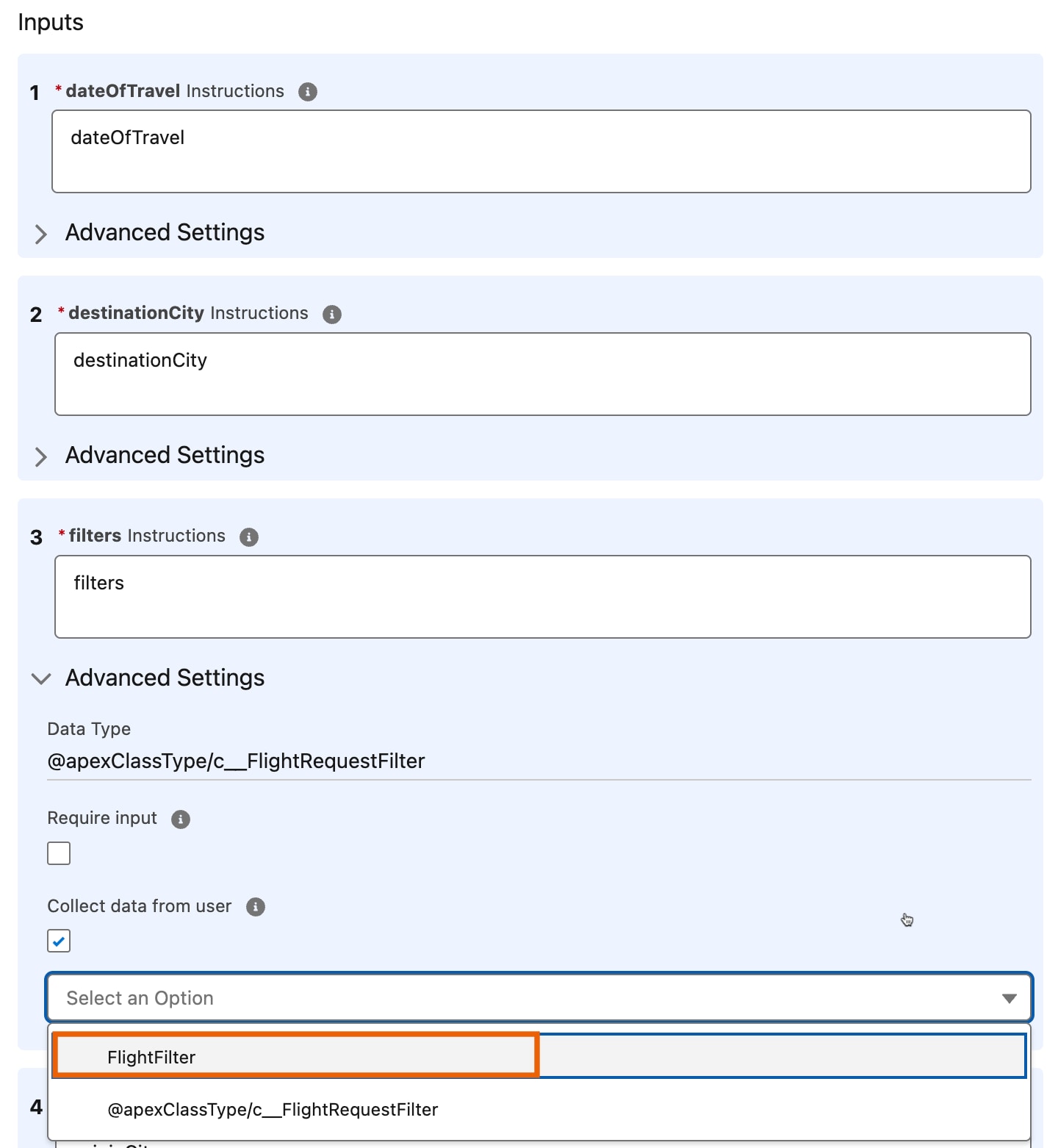
Before executing the agent action that you modified, reload the agent page. The agent prompts you to provide input and then generate the output. The input provides a new UI experience.
This image shows how the custom agent action’s input appears in an agent conversation.
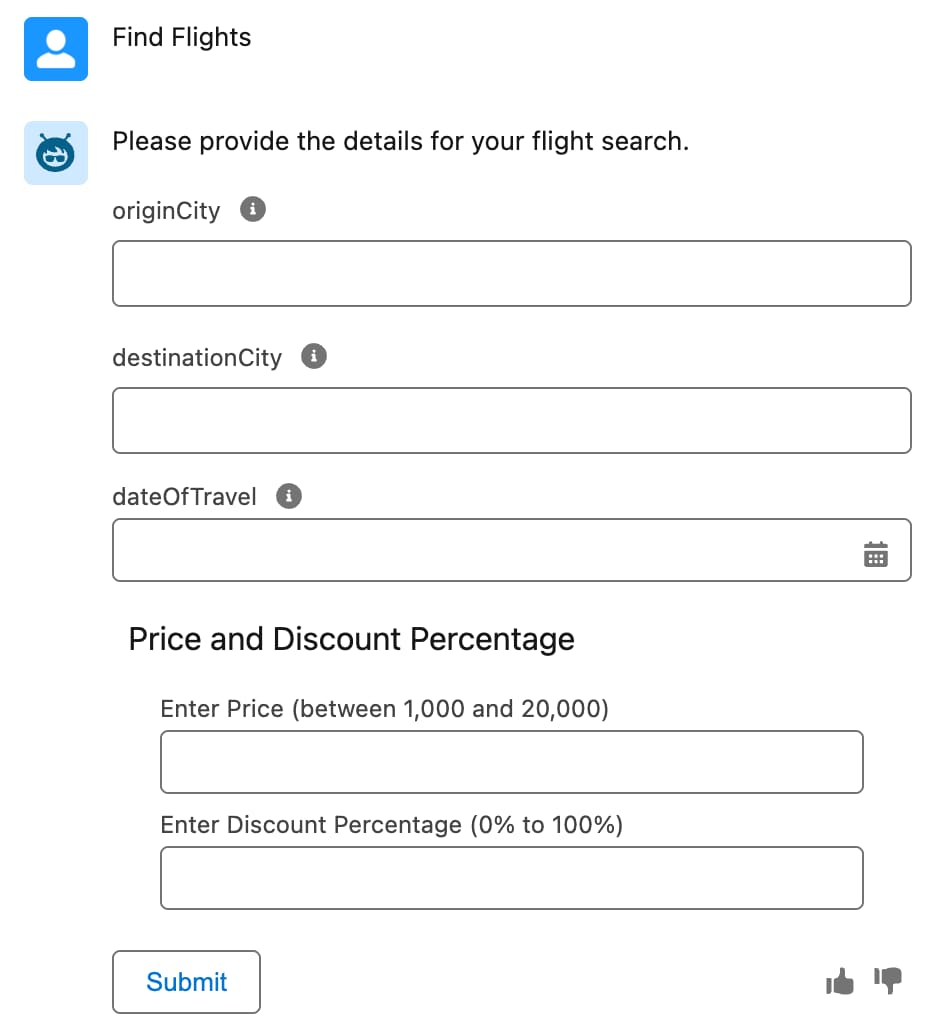
In certain instances the large language model (LLM) requests input as text, so make sure to accurately update the topic instructions for the correct selection of the Override Input component. For example, when you enter a prompt to find flights, the agent executes the Find Flight action. The Find Flight action executes by taking input through a UI form, and not in the form of Text because it includes a price and discount range.